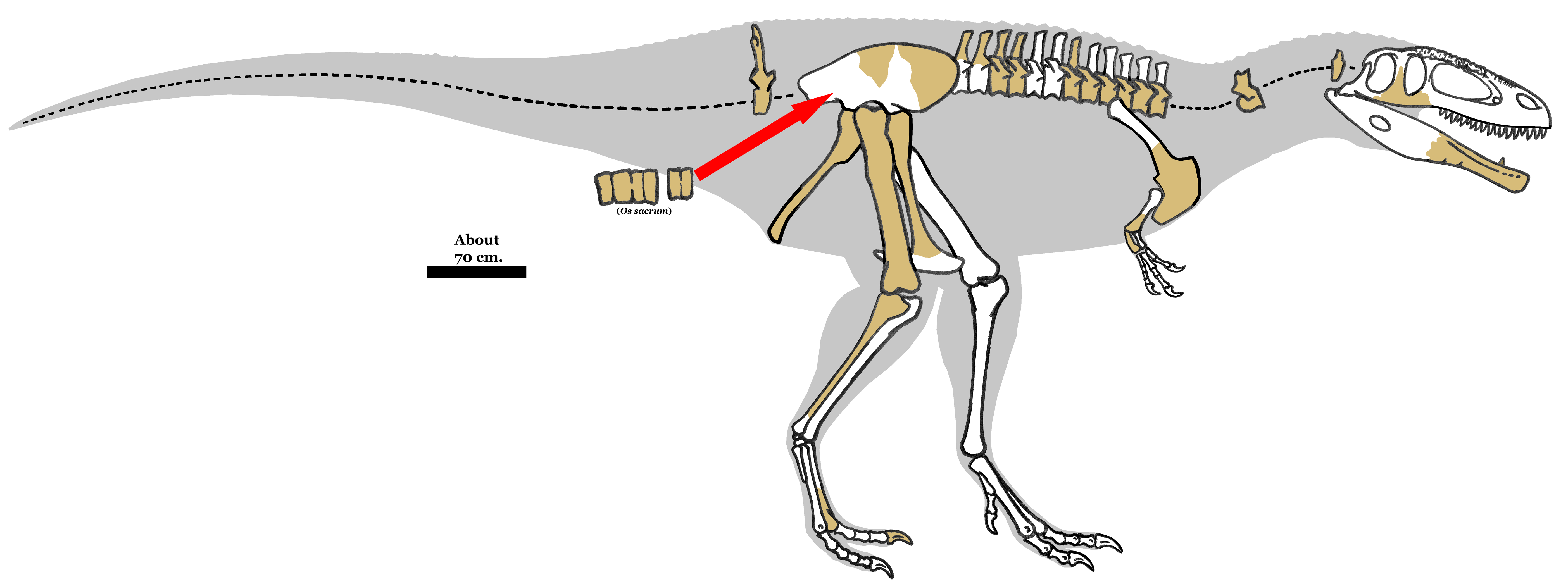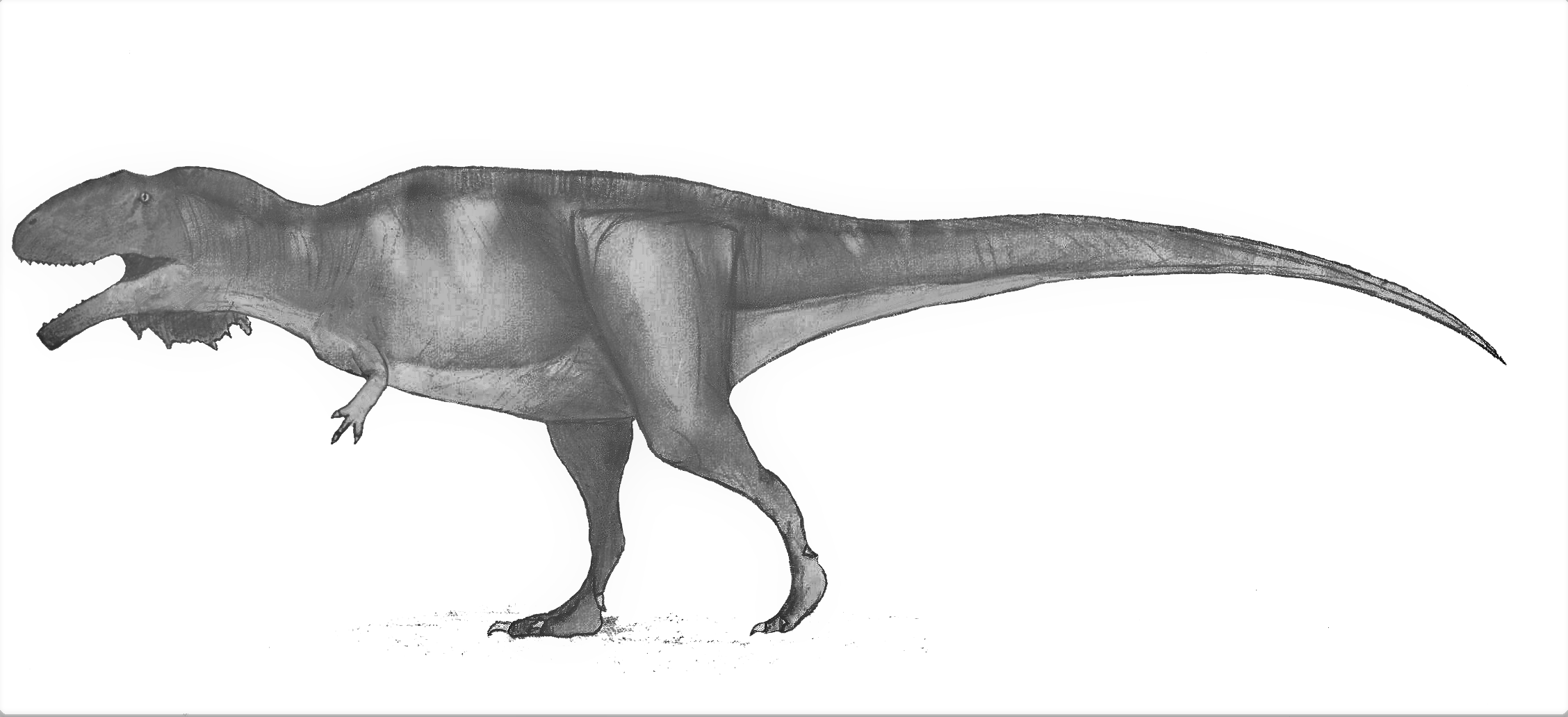|
Lajasvenator
''Lajasvenator'' (meaning "Las Lajas, Neuquén, Las Lajas hunter" after the city of Las Lajas in Neuquén, Argentina) is a genus of carcharodontosaurid dinosaur from the Mulichinco Formation from Neuquén Province in Argentina. The type species, type and only species is ''Lajasvenator ascheriae''. It was probably one of the smaller known Carcharodontosauridae, Carcharodontosaurids, being slightly more than half the length of ''Concavenator'', about . ''Lajasvenator'' is known from two specimens, MLL-PV-005 (the holotype) and MLL-PV-007 (a referred specimen). The referred specimen includes the proximal end of a cervical rib that is identical to the seventh cervical rib of the holotype. It is possible that the early evolutionary stage for the Carcharodontosauridae started with medium-sized predators like ''Lajasvenator'' that later diversified into the heavily-built taxa such as ''Giganotosaurus'' and ''Mapusaurus''. ''Lajasvenator'' is the oldest carcharodontosaur known from the Cr ... [...More Info...] [...Related Items...] OR: [Wikipedia] [Google] [Baidu] |
Giganotosaurini
Carcharodontosauridae (carcharodontosaurids; from the Greek language, Greek καρχαροδοντόσαυρος, ''carcharodontósauros'': "shark-toothed lizards") is a group of carnivorous theropod dinosaurs. In 1931, Ernst Stromer named Carcharodontosauridae as a Family (biology), family, which, in modern paleontology, indicates a clade within Carnosauria. Carcharodontosaurids include some of the largest land predators ever known: ''Giganotosaurus'', ''Mapusaurus'', ''Carcharodontosaurus'', and ''Tyrannotitan'' all rivaled ''Tyrannosaurus'' in size. Estimates give a maximum weight of for the largest carcharodontosaurids, while the smallest carcharodontosaurids were estimated to have weighed at least . Discovery and history The earliest discovery of carcharodontosaurid fossils may date to 1835 with the discovery of ''Poekilopleuron'' in Jurassic-aged sediments in Normandy, Normandy, France and it was then described in 1836 by French Natural history, naturalist Jacques Aman ... [...More Info...] [...Related Items...] OR: [Wikipedia] [Google] [Baidu] |
Carcharodontosaurid
Carcharodontosauridae (carcharodontosaurids; from the Greek καρχαροδοντόσαυρος, ''carcharodontósauros'': "shark-toothed lizards") is a group of carnivorous theropod dinosaurs. In 1931, Ernst Stromer named Carcharodontosauridae as a family, which, in modern paleontology, indicates a clade within Carnosauria. Carcharodontosaurids include some of the largest land predators ever known: ''Giganotosaurus'', '' Mapusaurus'', '' Carcharodontosaurus'', and '' Tyrannotitan'' all rivaled ''Tyrannosaurus'' in size. Estimates give a maximum weight of for the largest carcharodontosaurids, while the smallest carcharodontosaurids were estimated to have weighed at least . Discovery and history The earliest discovery of carcharodontosaurid fossils may date to 1835 with the discovery of '' Poekilopleuron'' in Jurassic-aged sediments in Normandy, France and it was then described in 1836 by French naturalist Jacques Amand Eudes-Deslongchamps. However, the holotype (name-bear ... [...More Info...] [...Related Items...] OR: [Wikipedia] [Google] [Baidu] |
Mulichinco Formation
The Mulichinco Formation is a geological formation in Argentina. It is Valanginian in age and is predominantly terrestrial, being deposited at a time of marine regression in the Neuquén Basin, and predominantly consists of siliciclastic Siliciclastic (or ''siliclastic'') rocks are clastic noncarbonate sedimentary rocks that are composed primarily of silicate minerals, such as quartz or clay minerals. Siliciclastic rock types include mudrock, sandstone Sandstone is a Clastic ... rocks.Schwarz et al., 2005 Fossil content Dinosaurs Ornithopods Sauropods Theropods Echinoderms Plants References Bibliography * * * * {{issn, 0305-8719 Geologic formations of Argentina Lower Cretaceous Series of South America Cretaceous Argentina Valanginian Stage Mudstone formations of Argentina Siltstone formations of Argentina Sandstone formations Deltaic deposits Fluvial deposits Formations Fossiliferous stratigraphic units of South America Pal ... [...More Info...] [...Related Items...] OR: [Wikipedia] [Google] [Baidu] |
2020 In Archosaur Paleontology
This article records new taxa of fossil archosaurs of every kind binomial nomenclature, described during the year 2020, as well as other significant discoveries and events related to paleontology of archosaurs that occurred in 2020. Pseudosuchians New pseudosuchian taxa Pseudosuchian research * A study on the skeletal anatomy and bone histology of ''Gracilisuchus stipanicicorum'', based on data from two new specimens, is published by Lecuona, Desojo & Cerda (2020). * Redescription of the anatomy of the postcranial skeleton of ''Riojasuchus tenuisceps'', and a study on the phylogenetic affinities of Ornithosuchidae, ornithosuchids, is published by von Baczko, Desojo & Ponce (2020). * Description of a new Erpetosuchidae, erpetosuchid specimen from the Upper Triassic Lossiemouth Sandstone (Scotland, United Kingdom) and a review of the anatomy, taxonomy and systematics of other erpetosuchid specimens from the Lossiemouth Sandstone (all previously referred to ''Erpetosuchus'') is ... [...More Info...] [...Related Items...] OR: [Wikipedia] [Google] [Baidu] |
Mapusaurus Roseae Restoration
''Mapusaurus'' ( Earth lizard) is a genus of giant carcharodontosaurid carnosaurian dinosaur that lived in Argentina during the Turonian age of the Late Cretaceous. Discovery ''Mapusaurus'' was excavated between 1997 and 2001, by the Argentinian-Canadian Dinosaur Project, from an exposure of the Huincul Formation (late Cenomanian–Turonian) at Cañadón del Gato. It was described and named by paleontologists Rodolfo Coria and Phil Currie in 2006. The name ''Mapusaurus'' is derived from the Mapuche word ''Mapu'', meaning 'of the Land' or 'of the Earth' and the Greek ''sauros'', meaning 'lizard'. The type species, ''Mapusaurus roseae'', is named for both the rose-colored rocks, in which the fossils were found and for Rose Letwin, who sponsored the expeditions which recovered these fossils. The designated holotype for the genus and type species, ''Mapusaurus roseae'', is an isolated right nasal (MCF-PVPH-108.1, Museo Carmen Funes, Paleontología de Vertebrados, Plaza Huincul ... [...More Info...] [...Related Items...] OR: [Wikipedia] [Google] [Baidu] |
Tyrannotitan
''Tyrannotitan'' (; ) is a genus of large theropod dinosaur belonging to the carcharodontosaurid family. It is known from a single species, ''T. chubutensis'', which lived during the Albian stage of the Early Cretaceous period in what is now Argentina. Tyrannotitan is considered a close relative of other giant carcharodontosaurids from Gondwana, such as ''Carcharodontosaurus'', but it shares an especially close relationship with the South American carcharodontosaurids ''Giganotosaurus'' and ''Mapusaurus''. ''Tyrannotitan'' is known from a few specimens, however none of them are very complete. Discovery and species ''Tyrannotitan chubutensis'' was described by Fernando E. Novas, Silvina de Valais, Pat Vickers-Rich, and Tom Rich in 2005. The fossils were found at La Juanita Farm, northeast of Paso de Indios, Chubut Province, Argentina. They are believed to have been from the Cerro Castaño Member, Cerro Barcino Formation (Albian faunal stage, stage). The holotype material was ... [...More Info...] [...Related Items...] OR: [Wikipedia] [Google] [Baidu] |
Concavenator UDL
''Concavenator'' (meaning Cuenca hunter) is a genus of carcharodontosaurian dinosaur that lived in Spain during the Early Cretaceous epoch, about 125 million years ago. The genus contains a single species, ''Concavenator corcovatus'', named and described in 2010 from a nearly complete skeleton collected from the Las Hoyas fossil site of the La Huérguina Formation. ''Concavenator'' was a medium-sized carcharodontosaurian, reaching about in length and in weight. Unlike most carcharodontosaurians, the neural spines of the last dorsal (back) vertebrae were tall, creating a sail-like structure. History The first fossil remains of ''Concavenator'' were recovered from limestone slabs of Las Hoyas locality (considered a '' Konservat-Lagerstätten''; deposits of exceptional fossil preservation) of Cuenca Province, Spain, which belongs to La Huérguina Formation. The remains were represented by an articulated, nearly complete skeleton of a theropod dinosaur individual encased in lime ... [...More Info...] [...Related Items...] OR: [Wikipedia] [Google] [Baidu] |
Concavenator
''Concavenator'' (meaning Cuenca hunter) is a genus of carcharodontosaurian dinosaur that lived in Spain during the Early Cretaceous epoch, about 125 million years ago. The genus contains a single species, ''Concavenator corcovatus'', named and described in 2010 from a nearly complete skeleton collected from the Las Hoyas fossil site of the La Huérguina Formation. ''Concavenator'' was a medium-sized carcharodontosaurian, reaching about in length and in weight. Unlike most carcharodontosaurians, the neural spines of the last dorsal (back) vertebrae were tall, creating a sail-like structure. History The first fossil remains of ''Concavenator'' were recovered from limestone slabs of Las Hoyas locality (considered a '' Konservat-Lagerstätten''; deposits of exceptional fossil preservation) of Cuenca Province, Spain, which belongs to La Huérguina Formation. The remains were represented by an articulated, nearly complete skeleton of a theropod dinosaur individual encased in lim ... [...More Info...] [...Related Items...] OR: [Wikipedia] [Google] [Baidu] |
Mapusaurus
''Mapusaurus'' ( Earth lizard) is a genus of giant carcharodontosaurid carnosaurian dinosaur that lived in Argentina during the Turonian age of the Late Cretaceous. Discovery ''Mapusaurus'' was excavated between 1997 and 2001, by the Argentinian-Canadian Dinosaur Project, from an exposure of the Huincul Formation (late Cenomanian–Turonian) at Cañadón del Gato. It was described and named by paleontologists Rodolfo Coria and Phil Currie in 2006. The name ''Mapusaurus'' is derived from the Mapuche word ''Mapu'', meaning 'of the Land' or 'of the Earth' and the Greek ''sauros'', meaning 'lizard'. The type species, ''Mapusaurus roseae'', is named for both the rose-colored rocks, in which the fossils were found and for Rose Letwin, who sponsored the expeditions which recovered these fossils. The designated holotype for the genus and type species, ''Mapusaurus roseae'', is an isolated right nasal (MCF-PVPH-108.1, Museo Carmen Funes, Paleontología de Vertebrados, Plaza Hui ... [...More Info...] [...Related Items...] OR: [Wikipedia] [Google] [Baidu] |
Eocarcharia
''Eocarcharia'' (meaning "dawn shark") is an extinct genus of theropod dinosaurs found in what is now the western Ténéré Desert of Niger. It is known from several skull bones collected in 2000 by an expedition to the Early Cretaceous (Aptian–Albian ages) Elrhaz Formation (Gadoufaoua locality) led by American paleontologist Paul Sereno. They were then described in 2008 by Sereno and Steve Brusatte. The genus contains a Monotypic taxon, single species, ''Eocarcharia dinops''. Sereno and Brusatte identified the remains as a new carcharodontosaurid, but later studies suggested that the species is chimaeric, comprising bones of multiple unrelated taxa. Some of the ''Eocarcharia'' material, including the holotype (name-bearing) specimen, likely belongs to a baryonychine spinosaurid. This would render ''Eocarcharia'' a member of this group, closely related to the coeval ''Suchomimus''. Meanwhile, the definitively carcharodontosaurid bones, a and teeth, belong to a separate distinct ... [...More Info...] [...Related Items...] OR: [Wikipedia] [Google] [Baidu] |








